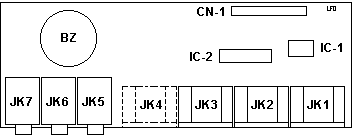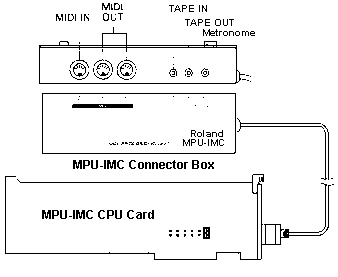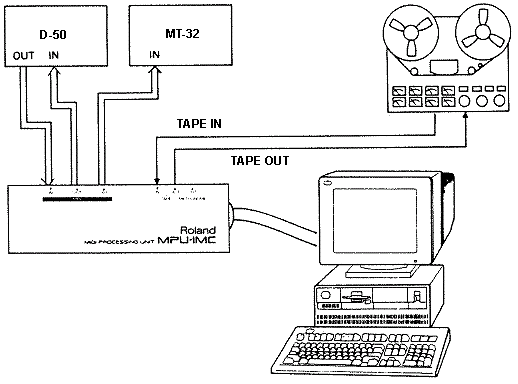|
@6C0F.ADF Roland Midi Processing Unit MPU-IMC
MPU-IMC User's Manual (Wimpy)
MPU-IMC Technical Reference Manual
MPU-IPC-T User's Manual
MPU-Ixx Circuit Diagram
MPU-IMC Service Notes, 1st Ed.
(originally from HERE)
MPU-401.zip Win 3.1x and W95 drivers.
mpudd103.zip Generic MIDI MPU-401 drivers, v1.04 ISA bus
Tested on 1.21, 1.3, 2.0, and 2.1 (beta)
mlab2v303.zip - The final distributed version, v3.03, of MidiLab/2 for OS/2
mlabuart.zip - MidiLab/2 exposed! All source and build files
MIDIfile Midifile DLL (OS/2?)
MIDIsrc PS/2 Roland MIDI driver source code (freeware)
bb.zip Band in a Box (thx to Bradley Parker)
MPU-IMC Photos & the P70 used to house it (retrosynth.com)
MidiLab/2
by James Bell
Roland MPU-IMC
MIDI Processing Unit
MPU-IMC Connector Board
MPU-IMC Kit
MPU-IMC Setup Example
PS/2 + MPU-IMC Hardware Bug
MPU401, Smart, Dumb, UART?
ADF Sections
Roland MPU-IMC FCC ID DKDMPU-IMC
![Front [P]](/other/img/photo.gif)
![Back [P]](/other/img/photo.gif) | |
![Front (alt) [P]](/other/img/photo.gif)
![Back (alt) [P]](/other/img/photo.gif)
This is the MCA version of the MPU-401 MIDI Processing Unit.

IC1 LC3517AL-15K 2Kx8 SRAM
IC2 HG62E08R10FS gate array
IC3 Hitachi 6801V0B55P
|
IC16 Mitsubishi M5218A Dual Op-Amp
IRQ IRQ selection jumpers or pads only
P1 Female DE9 connector
|
IC3 Hitachi 6801V0B55P R15179222 ISA/MIDI
Timing/Interfacing/Intelligent mode MCU
MIDI Processing Unit

MPU-IMC Connector Board

BZ Buzzer
CN-1 Header to DE9
IC-1 Sharp PC900
IC-2 Hitachi HD74LS05P
JK1 MIDI IN
JK2 MIDI OUT
|
JK3 MIDI OUT
JK4 Empty solder pads
JK5 Tape IN
JK6 Tape OUT
JK7 Metronome
|
MIDI Processing Unit CN-1 Pinout
(thx to Cary Roberts of Retrosynth)
The external connector box has a 74LS05 to
drive the MIDI out and MIDI thru, and a Sharp PC900
optoisolator for the MIDI in. I've listed the pinout of
the DE9 connector below.
| Pin | Description |
|---|
| 1 | Ground |
| 2 | TTL MIDI In |
| 3 | Metronome Out |
| 4 | Tape In |
| 5 | +5 V |
| 6 | Ground |
| 7 | TTL MIDI Out |
| 8 | Tape Out |
| 9 | +5 V |
MPU-Ixx Schematic
A scan of the schematic is HERE.
Sourced from the MPU-IPC-T Technical Reference. Some of the chip IDs differ
between the Micro Channel and and ISA versions.
MPU-IMC Kit

MPU-IMC Setup Example

PS/2 + MPU-IMC Hardware Bug
Mike W. Burger wrote:
I got my new copy of Band-in-a-Box. It did not run on my PS/2 with
a "standard" Roland interface, the MPU IMC. I have had weird hardware and
software problems that nobody could explain since I bought this card. Finally,
someone (BiaB) explained in their manual the unbelievable truth. A board that
can only be used in a single computer on a single buss structure (Micro Channel
IBM) comes from the factory set up to conflict with the system's boot device!!
This is not documented in the nearly invisible Roland manual. There is no
mention of the ability to change the IRQ. No other software product seems aware
of this difficulty which strikes a fairly large percentage of people attempting
to use the MPU-IMC in a PS/2.
I reset the IRQ on the MPU IMC using the only instructions available, the
markings on the PC board itself. I reset SoundWrite V, Sound Quest editor and
BiaB to use IRQ7 and the stock address of $330 and all appears to be working
much better. Since this appears to be unique information, a section of the BiaB
manual is reproduced here for other Roland victims.
Since the phone company has no listing for PD Music which supposedly is the
USA branch of the company making Band-in-a-Box, and if they exit they have
taken pains not be contacted, the following is quoted from the BiaB manual:
IBM PS/2 with MPU IMC
There are frequently IRQ interrupt conflicts on the PS/2. The original MPU
IMC cards were reportedly hardwired to IRQ2 which had a conflict with the hard
disk interrupt. Newer MPU-IMC are IRQ adjustable by a jumper switch on the
card. The factory setting is IRQ9 which also conflicts with those using IDE
drives. The best setting seems to be IRQ7. If you start Band-in-a-Box and are
greeted by "Stack overflow". It means that you have a hardware conflict and
must set the IRQ on the MPU-IMC.
Program locks up when trying to load in songs.
This means that you have a IRQ conflict with the disk drive controller,
which is not noticed until the program tries to access the hard drive. You must
change the IRQ setting on the MPU 401.
Other locking up.
This is almost always due to IRQ hardware conflict. Try to change the IRQ on
your card from IRQ2 to another setting like IRQ7 or IRQ 5. IF your MPU401
doesn't allow you to change IRQ, then try setting Band-in-a-Box to a different
IRQ anyway.
The last trick listed above is an attempt to disable interrupt handling and
count on the program's polling to get the job done. A number of pieces of
software will work with the IRQ screwed up, at least to a point. Also, you will
get strange boot problems after the MPU IMC is installed, since it will often
generate spurious interrupts when powering up along with the disk drive.
On the newer MPU IMC cards, there is a line of double pins and a small
square blue shorting block that can be moved. The area is labeled "IRQ". There
are about six numbered pairs including 9 and 7.
MPU401, Smart, Dumb, UART?
Patrick Aalto:
> What are the different between MPU401 smart, dumb, and UART mode
compatibility? Will MIDI tools, windows, dos, and games use the same mode?
MPU-401 "smart mode" is available on real Roland MPU-401 compatible cards
(like MPU-IPC, MPU-IMC, LAPC-I, SCC-1). That mode uses the processor on the
MIDI card to handle the data output to MIDI devices. I don't know very well how
the processor reads the data from the main memory of the PC, but in any case it
generates IRQ every now and then, requesting a new data block to be sent. All
timing (tempo) is handled by the MIDI card processor. I seem to remember that
it only supports 8 or 16 tracks, and the available tempo and timebase values
are a bit coarse, which is why this mode is not used on newer sequencer
programs.
MPU-401 "dumb mode" is a mode that the real MPU card can be programmed into,
after which it behaves like a dumb UART device. All data that a program wants
to send to a MIDI device must be sent by outputting the MIDI data bytes to the
MPU data port (at the correct time), and input data must be read by polling the
'data available' bit and then reading the data port. This is the mode that all
newer sequencer programs use. This mode does not require the MPU card IRQ to be
available. (I once removed the IRQ selection jumper totally from my Roland
SCC-1, and only Prism sequencer program stopped to work. Cakewalk for Windows
etc. worked without problems).
MPU-401 "UART mode" is, I believe, used by clone MIDI cards. That is like
the "dumb mode", but the card does not have to be programmed into it, since
that is the only mode these clone cards support. This might cause problems with
some programs that support MPU-401 dumb mode, if these programs want to program
the card into this mode first, and don't get the correct reply for this
command.
These comments were just my understanding of the matter, not necessarily
correct.
ADF Sections Roland MIDI PROCESSING
UNIT MPU-IMC (AdapterId 6C0F)
Port Address Select
I/O port address can be primary (0330-0331h) or alternate
(1330-1331h). To use the alternate address, you need a software that fit it.
<"Primary"
(0330h-0331h int 2)>, Alternate (1330h-1331h int 2)
|